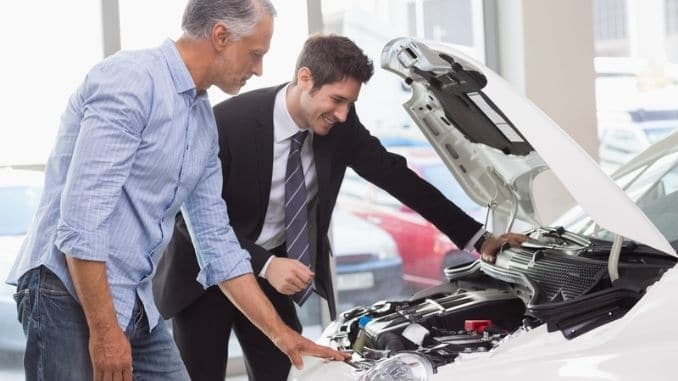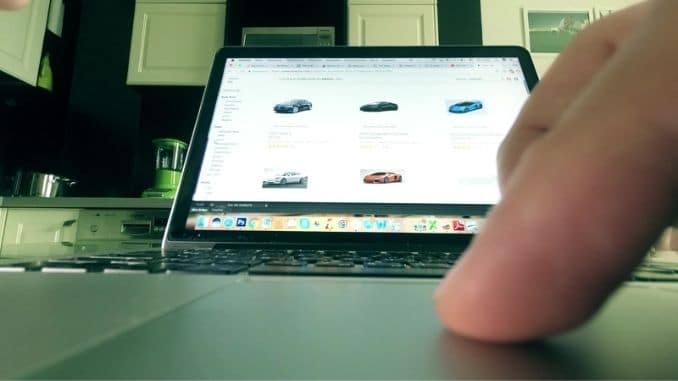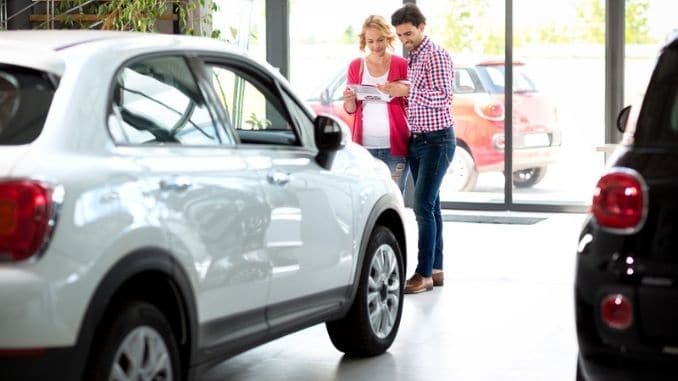
Buying a car can be an exciting experience, but it can also be overwhelming and confusing, particularly if you get sucked into a deal that you didn’t want.
According to a 2016 Harris Poll, 87 percent of adults dislike something about the process of purchasing a vehicle at a traditional car dealership. More than three in five (61 percent) feel like they’ve taken advantage of at least some of the time when shopping for a car, and over half feel anxious or uncomfortable when visiting a car dealership.
To make sure you enjoy your car-buying experience, follow these 10 tips.
1. Know What You Can Afford
It’s all too easy to get lured into a higher-priced car than you can afford, particularly when the dealer is pointing out all the fun features like the leather seats and amazing stereo system. Take a look at your budget and credit rating. If you need to, take some time to put aside a little money to use as a down payment.
If your credit rating could use some improvement, review your credit reports, get a handle on your bill payments, and limit your requests for new credit (such as applying for a new credit card) for at least a couple of months.
Once you’ve got everything in order, decide on your upper limit for a car and stick to that.
2. Shop Around for the Best Rate
Though many dealerships can get you a good financing deal, some will offer you a loan at a higher interest rate than what you could get elsewhere so they can divide the profits with the finance company.
It never hurts to check with your mainstream banks or credit unions to see what they may be able to offer you on a car loan before you go to the dealership. Then you have an idea of what you qualify for, and won’t be taken in by bad deals. Simply call your financial institution and ask them what they can do for you in terms of their lowest auto-loan interest rate.
Do be aware of shady lending operations online. It’s always better to stick with the banks and credit unions that you recognize and trust.
You can go so far as to get preapproval on a loan before you go car shopping. Then the dealer will take you seriously. If they give you a better deal through their financing, feel free to take it.
3. Research Your Trade-In
First, determine whether you want to trade in your current vehicle. Take this decision seriously. If you want to keep your old vehicle, decide that first so you won’t risk having a car salesman talk you out of it.
If you decide that trading in your vehicle is the best option, do some research on its value so you’re armed with that information when you go to the dealership. If they don’t offer you enough, you won’t be fooled and will be in a stronger position to negotiate.
Good places to check for free pricing guides include the following:
• Edmunds.com
• Kelly Blue Book
• NADA
You can also research vehicles like yours on Autotrader to see what people in your area are asking for them. Remember that the trade-in value will be lower than the direct sale value. In other words, a dealership will give you less money on your vehicle than would a private owner, but a dealership can save you the hassle of having to personally sell the vehicle.
Trading in your vehicle also gives you a tax break. In most states, you’ll only pay tax on the difference between the price of your new vehicle and the trade-in value of your old car. The portion of the price that’s covered by your trade-in is essentially tax-free.
4. Research the Vehicle You Want
Before you go car shopping, think about the type of vehicle you want. Are you mostly interested in comfort, gas mileage, or safety features? Do you need extra cargo space, or are you seeking a fun driving experience?
Other questions to ask yourself include:
- How many people will you typically carry in this new vehicle?
- How much cargo room will you need?
- Will you be using the vehicle to transport large items?
- Do you care if the vehicle is fun to drive?
- How much power do you want in the engine?
- What is your preferred fuel economy?
- What safety features would you like? (today’s options may include brake assist, lane departure warning, forward collision warning, automatic emergency braking, and more)
Once you have a better idea of the type of car you’re looking for, start looking at car review websites. These can give you good information on the car’s safety, reliability, and performance. You can find reviews from real people as well as auto experts, and get a broad perspective of how each vehicle compares to the others.
Some good websites for this type of research include:
• Cars.com
• Car Gurus
• TrueCar
• Auto Cheat Sheet
• Edmunds Car Reviews
• Kelly Blue Book Car Reviews
• MotorTrend Car Reviews
5. Research the Dealerships In Your Area
Once you have a pretty good idea of which car you want, research the dealerships near you before you go shopping. You can find online reviews from other buyers that can give you insights into a dealership’s integrity and quality of service.
Most dealerships are likely to have one or two bad reviews along with mostly good reviews, but if you see several bad reviews, you’d probably be best to avoid that dealership. On the rest, read what the customers had to say and keep their comments in mind when you’re shopping.
A couple of bad reviews doesn’t mean the company should be avoided. Sometimes customers bring their own issues to the interaction that can taint their experience. But doing your research ahead of time will help you keep your eyes open during your transaction.
Good locations for dealership reviews include:
• Google (simply search for the dealership online and read the customer reviews)
• Dealrator.com
• CarDealerCheck.com
• Cars.com
• Edmunds.com
6. Look for Your Vehicle Online
You can make your car shopping a lot more efficient by beginning online before you drive around to dealerships. That’s because most dealerships now list their inventory not only on their websites but also on several car shopping websites as well.
All you have to do is put your desired make, model, and year (if desired) into the search box, along with how many miles you’re willing to travel for your car, and the following sites will show you the available vehicles near you. You can look these over, and if you find one that looks like it fits your criteria, make a trip to see it in person.
Some good car-shopping sites include:
- Car Max
- Edmunds
- Autotrader
- True Car
- Car Gurus
- AutoBlog
7. Check the Vehicle’s History
Did you find something you liked online or at the car dealership? Check the vehicle’s history. You can find readily available information online that can help you avoid vehicles that have been in accidents, have salvage titles, or are otherwise undesirable. Some reports will also show you if regular maintenance was performed on the vehicle and where it was done.
Your dealerships may show you the car’s history report for free. If not, you can look it up yourself at the following sites. You may have to pay a fee for the report.
- CarFax
- AutoCheck
- Vehicle History
- National Insurance Crime Bureau (tells you if the vehicle was ever stolen)
- Kelly Blue Book
- VinCheckPro
If any of these reports signal issues such as an accident or poor maintenance, that doesn’t mean you can’t buy the vehicle. It is best to shop around, though, and see if you can find a cleaner model.
8. Set Up a Test Drive
You may find a vehicle that seems to check all your boxes, but the true test takes place when you drive it. To make sure your test drive is effective, drive the car the way you would normally drive it in your everyday life. If you commute, for example, try it in stop-and-go traffic and at highway speeds. If you like to take your vehicle camping, find some nearby hills to climb.
It often helps to take someone with you at this step, particularly if you are nervous when dealing with car salespeople. Having a knowledgeable friend or even just a supportive one can help you feel more confident in your decisions, and will make it less likely that you’ll be drawn into a deal that you don’t want.
Other good steps to take during your test drive include:
- Drive over bumps to test the suspension
- Check the brakes
- Take tight corners in a safe location to see how the car responds
- Get in and out of the car several times
- See how you feel in the driver’s seat—can you reach everything? Does it feel comfortable?
- Pop the hood and listen to the engine—hear any weird clacking or whining sounds?
- Leave the stereo off during the drive and listen to the engine to detect any strange noises it shouldn’t be making
- Check the cargo space
- Try all the seat belts
- Bring your child’s car seat along and test for fit and ease of installation
- Take your time and don’t let the salesperson pressure you
- Test the stereo when you get back to the dealership
- Test the air conditioning and heat
- Examine the outside of the car, looking for any dings, dents, worn tires, broken glass, and scratches
- Check under the car for any hanging parts or leaking fluids
It’s always best to test-drive three or more cars so you can compare. It’s also best to drive the one that you’re interested in more than once (three times is best) on separate days. This brings us to tip number nine.
9. Never Buy a Car on the Same Day
You may have test-driven several cars and feel like you have found “the one,” but never purchase a car on the first day that you drive it. If the salesperson is pressuring you to do just that, take that as a warning sign.
All you have to do is tell the person that you’re going to think about it and leave. The odds that someone else will swoop in and buy your car overnight are very slim. Give yourself time to go home, research the car and price some more if you like, and allow your test driving experience to simmer. If you still are interested the next day, you can return and drive the car again.
10. Negotiate a Deal
When you’re finally ready to buy the car, it’s time to start negotiations with the salesperson. At this point, it’s important not to tip your hand. Don’t talk about how much you want the car. Maintain your power position by simply remaining curious about what the dealer can do for you. Remember that you can always walk away if you don’t like their offer.
Remember to come armed with your research on what the car should cost, and what your trade-in is worth. Don’t allow the dealer to sway you with talk of “low monthly payments.” Negotiate the total cost of the car. If the dealer won’t come down on the price, ask about accessories or services they may throw into the deal for you.
Finally, make sure to ask about fees. Most dealerships will add fees to the sales price. These typically include sales taxes and finance charges, as well as documentation fees and other fees. Ask for an itemized list of each one and expect an explanation for each.
Some common fees that you want to look at closely and potentially negotiate include:
- Documentation fees: It’s normal to have the buyer cover the cost of the title and registration, but dealers may charge extra for processing these. Try asking for a discount or some extra car accessories.
- Advertising fee: Some dealers add a fee to cover the cost of advertising the car. Try to get this fee removed.
- Service Plans: A service plan is a prepayment of service costs for a specific period. You may get a slight discount overpaying for the services individually, but the plans are worth it only if you keep the car for the duration of the plan.
- Destination and delivery: These are for the cost of transporting your car to your dealer. The dealer may also include fees for “dealer prep” or “vehicle prep.” Make sure the costs are reasonable and feel free to contest them.
- Extra protection: Dealers will offer paint protection, rust protection, fabric protection, and the like. You won’t need most of these, so review them carefully.
- Loan payment fees: Make sure you understand the loan payment terms before you sign the deal. Some charge unnecessary customer service fees.
- VIN etching: This is an anti-theft measure that etches the vehicle’s VIN on the glass. Usually, a dealer will charge you more for this service than your local mechanic will. You can even do it yourself.
- Extended warranty: This covers repairs after the manufacturer’s warranty expires. It may give you peace of mind, but it can cost thousands. It may be smarter to set aside an emergency fund instead.
Remember, your best defense against paying exorbitant fees or dealing with a salesperson who refuses to negotiate is to walk away. There is likely another dealership that will be more accommodating and in the end, feeling happy with your purchase is worth taking a little more time.
Learn the best techniques for eliminating stress from your life. Click here to discover how.











